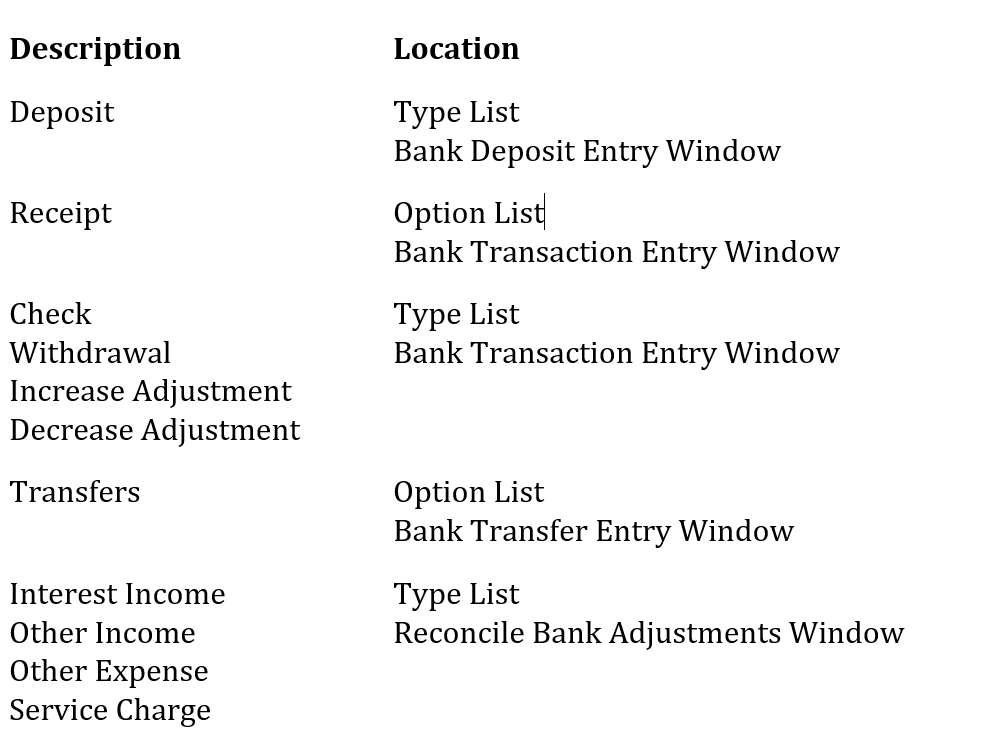
You can use Bank Reconciliation to enter and maintain checkbooks used to pay vendors, employees, distribute petty cash, and to reconcile bank statements. If you’re using Payables Management and Payroll, checks printed and posted from those modules update checkbooks in Bank Reconciliation.
You also can use Bank Reconciliation to complete the following tasks:
The manual is divided into the following parts:
This part of the documentation provides the procedures required to set up Bank Reconciliation, and for moving your existing reconciliation information into your Microsoft Dynamics GP system. Setup procedures generally need to be completed only once, but you might want to refer to this information again when verifying your setup information, and when maintaining your checkbooks.
The following topics are discussed:
You must set up several options in System Manager, General Ledger, and Multicurrency Management before setting up Bank Reconciliation.
You must complete these setup procedures before you can enter or post transactions, or reconcile your checkbooks. Once you register Bank Reconciliation, your system immediately begins tracking checkbook-related transactions entered in other modules, and updates Bank Reconciliation.
Don’t register Bank Reconciliation until you’ve set up the checkbooks and cash accounts.
This information is divided into the following sections:
When you set up Bank Reconciliation, you can enter or void transactions and deposits. After posting, you can print audit trail reports and transaction reports to analyze the accuracy of your records, and to simplify edits. You can review the report information before reconciling your checkbook.
When you reconcile your checkbook, you’ll enter reconciliation dates, mark cleared transactions, enter adjusting entries, and enter any cleared differences.
Whether you’re setting up your system for the first time or upgrading an existing system, you must reconcile the checkbooks in your existing system before using Bank Reconciliation.
Before you set up Bank Reconciliation
Before you begin setting up Bank Reconciliation, be sure to set up the following information:
To print multicurrency information on your posting journals and reports, mark Include Multicurrency Info in the Posting Setup window. See the System Setup instructions (Help >> Contents >> select Setting Up the System) or the General Ledger documentation (Help >> Printable Manuals) for more information about completing these setup tasks.
Setting up default entries for Bank Reconciliation saves you time when you enter and analyze data, and enables you to customize your transactions.
This information is divided into the following sections:
Use the Bank Reconciliation Setup window to set up information that makes data entry and tracking easier. You should post all transactions in other modules, and reconcile existing checkbooks in your previous system, before entering information in this window.
Next transaction number
This number appears as the default number for the transactions and receipts you enter using the Bank Transaction Entry, Bank Transfer Entry, and Reconcile Bank Adjustments windows. The transaction number automatically increments to the next available number after you post a transaction or receipt, but you can change the number.
Transaction descriptions and default codes
Use the transaction type description to distinguish among the transactions you enter in Bank Reconciliation. For example, if your company refers to interest income as interest gained, you could change the description to Interest Gained, which would then appear in the Reconcile Bank Adjustments window. However, even if you change the description, the underlying functionality stays the same. The code is a short description of the transaction type, which appears as a prefix to the numbers in Bank Reconciliation windows and on transaction reports. The code, next number, and leading zeros create a 12-character number for all transaction types, except for checks and deposits. Default check and deposit numbers are entered using the Checkbook Maintenance window.
For example, suppose you’re entering a withdrawal using the Bank Transaction Entry window. If you set up WDL as the code for withdrawal transactions and 100 as the next number, the number would be WDL000000100 for your first withdrawal transaction. You can change any code or description to match your business. The following table explains where each item appears:

History
If you keep transaction/reconciliation history, all account distribution information and posted transactions are stored, so you can reprint posting journals and view the original transaction using the inquiry windows.
Default checkbook ID
Use this field to select a checkbook ID to appear as the default checkbook ID when you’re entering transactions using the Bank Transaction Entry window. You should select the checkbook you use most often when entering transactions.
You can select any checkbook as the default checkbook, regardless of whether it is active or has a Cash account assigned to it. You also can inactivate or delete the checkbook that has been selected as the default checkbook in the Bank Reconciliation Setup window.
Although any checkbook can be selected as the default checkbook, you can’t enter or post transactions in a checkbook that’s inactive, or that doesn’t have a Cash account assigned to it.*
If you’re using Multicurrency Management, you can select any checkbook as the default checkbook, regardless of the following situations. However, you can’t enter or post transactions in a checkbook in these situations:
User-defined fields
Use these fields to track additional information about your checkbooks. These fields are displayed in the Checkbook Maintenance window.
Use the Bank Reconciliation Setup window to set up your default entries in Bank Reconciliation.
To set up Bank Reconciliation default entries:
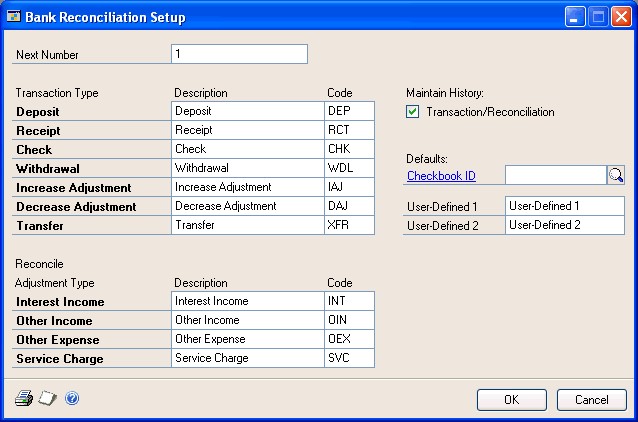
Checkbooks enable you to keep records of your bank deposits and cash paid out so that you can reconcile them with your bank statements. Checkbooks are available throughout the system, regardless of what other modules you purchased.
If you have Multicurrency Management registered, you can use Bank Reconciliation to set up checkbooks for each currency you use.
This information is divided into the following sections:
You can set up an unlimited number of checkbooks to manage your company’s cash. We recommend that you set up separate checkbooks for each Cash account so you can more accurately track payments and receipts. For example, you might want to set up separate checkbooks for payroll checks, credit card payments from customers, and payments to vendors.
You can use checkbooks throughout your system to track cash transactions. Because of this integration, new customers must set up their checkbooks and register Bank Reconciliation before posting transactions in other modules. However, existing Microsoft Dynamics GP customers who are setting up Bank Reconciliation have two options for setting up checkbooks:
Before you can post credit card transactions to Bank Reconciliation, you must set up the card using one of two ways, depending on how you’re using it.
Assign each checkbook to its own Cash account to prevent confusion and to make it easier to reconcile checkbooks to the Cash account in General Ledger. The Cash account must be a posting or allocation account that does not have any unit accounts assigned as one of the distributions.
If you’re using Multicurrency Management, assign each currency its own checkbooks and Cash accounts. You can assign each currency to unlimited checkbooks.
If you’re using Receivables Management, Payables Management, or Payroll, verify that your Customer Account Maintenance, Vendor Account Maintenance, and Employee Maintenance windows are set up to use the Cash accounts from the correct checkbook. Doing so makes it easier to reconcile your Cash account to the checkbook.
Check and deposit numbers can be alphanumeric. If you enter alphabetic characters, the numerals—not the letters—will increment as you process checks and enter deposits.
By defining the next number in the Checkbook Maintenance window, you also are determining the number of unique numbers that will be available. For example, if you enter CK001 as the next check number, you can enter only up to 999 unique checks. Be sure to enter a number that’s large enough to accommodate your organization’s needs.
If alphabetic characters are entered between numbers, only the numbers to the right of the last letter you entered will be incremented. For example, if the next check number is CK00M18888, the following check number will be CK00M18889.
When you set up new checkbooks, the last reconciled balance is the checkbook’s current balance. You can make changes to this amount until you reconcile the checkbook for the first time. If you change the last reconciled balance after saving the checkbook, you must enter an adjustment in General Ledger for the Cash account, because an adjusting entry won’t be automatically entered.
After you reconcile a checkbook, the amount in the Last Reconciled Balance field is the same as the bank statement’s ending balance in the Reconcile Bank Statements window. You can’t change this amount using the Checkbook Maintenance window.
Use the Checkbook Maintenance window to set up checkbooks. You can add checkbooks at any time, and you can select one as the default checkbook in other modules’ setup windows. Selecting a default checkbook streamlines your data entry process.
To set up a new checkbook:
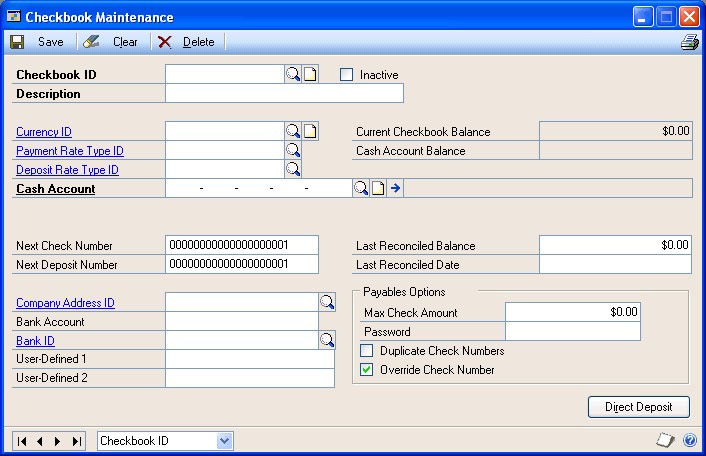
Note After reconciling the first time, the date and balance fields are updated each time you reconcile. You can’t make changes to these fields using this window.
Use this procedure if you have an existing checkbook that you want to continue using in Bank Reconciliation. Any checkbooks you previously set up appear in Bank Reconciliation when you register the module.
As soon as you register Bank Reconciliation, any transactions assigned to a checkbook are posted to Bank Reconciliation. For this reason, we recommend that you post all transactions and reconcile your existing checkbooks before registering Bank Reconciliation.
To use an existing checkbook:
Use the Checkbook Maintenance window to make a checkbook inactive, which prevents new checks or receipts from being entered for that checkbook. You can still complete the following tasks when the checkbook is inactive:
To inactive a checkbook:
If a checkbook has become obsolete and you’re no longer planning to use it, you can delete it under the following circumstances.
To delete a checkbook:
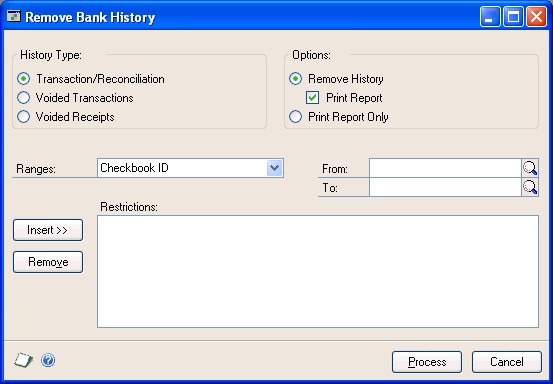
Use the information in this part of the documentation to ensure that your checkbooks accurately reflect the transaction detail that appears on your monthly bank statements. You can enter transactions to update your Cash account and checkbook balances, to enter receipts and deposits, and to reconcile your checkbook.
The following topics are discussed:
Because Bank Reconciliation integrates with several other modules and has multicurrency functionality, there are some transaction requirements and recommendations you should understand before using this module.
This information is divided into the following sections:
Whenever you enter a transaction in another module that uses a checkbook, Bank Reconciliation is updated. Therefore, you should use the Bank Reconciliation transactions only to record those miscellaneous transactions, receipts, and deposits not recorded elsewhere.
If you enter a transaction in another module and then enter it again in Bank Reconciliation, the checkbook and Cash account will be updated twice and your accounts won’t reconcile properly.
Transactions that are voided in other modules will be listed on Bank Reconciliation reports. Transactions that were originally entered before the reconciliation cutoff date and that were voided after the cutoff date are listed as outstanding transactions. (The reconcile cutoff date is entered in the Reconcile Bank Statements window.)
The Checkbook Register Inquiry window and the Checkbook Inquiry Report list transactions that were voided after the date range entered for the report as outstanding transactions.
Posting moves transactions to permanent records. In Bank Reconciliation, posted transactions and reconciliation adjustments update the General Ledger Cash accounts and checkbook balances. When you post deposits, only Bank Reconciliation is updated, unless you have gains or losses. When you post receipts either in Bank Reconciliation or in other modules, the General Ledger Cash account is updated. When you post transfers, the Cash accounts and the checkbook balance all are updated.
If you’re using Multicurrency Management, any gains or losses associated with a deposit are posted to the Realized Gains/Losses account.
Bank Reconciliation uses only transaction-level posting, which means you must enter and post bank transactions individually. Your settings in the Posting Setup window also must enable transaction-level posting for Bank Reconciliation. See the System Setup instructions (Help >> Contents >> select Setting Up the System) for more information about posting setup. You can post only to an open period that’s been set up using the Fiscal Periods Setup window. Bank Reconciliation records are updated using the date you entered in the Bank Transaction Entry, Bank Transfer Entry, Reconcile Bank Adjustments, or Bank Deposit Entry windows.
You can enter and save deposits for posting later, but you can save only one deposit with receipts transaction or one deposit to clear receipts transaction for each checkbook at any given time.
If you choose to post to General Ledger, the transactions appear in a batch in the General Ledger Batch Entry, Series Posting, and Master Posting windows. If necessary, you can edit the transactions using the Transaction Entry window in General Ledger. Your General Ledger accounts are updated when you post the batch in General Ledger.
If you’re posting to General Ledger, the audit trail code for the transaction identifies the transaction origin. Receipts from other modules follow the General Ledger posting specifications set up for the originating modules.
All transactions posted during a single data entry session use the same audit trail code. For example, if you enter and post five deposits with receipts using the Bank Deposit Entry window, and you close the window, all five deposits have the same audit trail code and are printed on the same posting journal. Use the audit trail code to trace the posting sequence of any transaction back to the originating journal.
When you post transactions, deposits, or transfers, and you close the window, the Bank Transaction Posting Journal, Bank Deposit Posting Journal, or Bank Transfer Posting Journal is printed automatically, if you selected to print those reports in the Posting Setup window. These posting journals provide details about the transactions or deposits you posted. After posting, you can view the transaction and deposit information on reprinted posting journals, or using the Bank Transaction Entry Zoom, Bank Deposit Entry Zoom, or Bank Transfer Entry Zoom windows.
To include Multicurrency information on posting journals and other reports, mark Include Multicurrency Info in the Posting Setup window.
If you’re using Multicurrency Management with Bank Reconciliation, you can choose the currency to enter on checks.
This information is divided into the following sections:
If you’re using Multicurrency Management, the following rules apply when entering transactions.
Gain and Loss accounts you set up using the Multicurrency Posting Account Setup by Rate Type window. If no Realized Gain or Loss accounts have been set up using this window, the accounts set up using the Multicurrency Posting Accounts Setup window or Posting Accounts Setup window are used.
If you’re using Payables Management, you can make payments in any currency for a checkbook with an assigned functional currency. If the checkbook being used doesn’t have an assigned functional currency, you can make payments only in the checkbook currency.
The following rules apply to deposit and receipt transactions.
If a transaction’s currency ID is not in the functional currency, a rate type and associated exchange rate table are assigned to the transaction. The rate type is the default rate type from the selected checkbook. If one isn’t assigned to the checkbook, the default rate type for the Financial series specified in the Multicurrency Setup window is used. You also can choose the Currency ID expansion button to open the Exchange Rate Entry window, where you can view or modify the default exchange rate.
The document date assigned to a transaction determines the exchange rate to use, based on the currency ID and associated rate type entered for the transaction. Each time you change the document date on a multicurrency transaction, the system searches for a valid exchange rate. If a valid rate doesn’t exist, you can enter an exchange rate using the Exchange Rate Entry window. If you entered a General Ledger posting date that’s different from the document date, the exchange rate expiration date must be after the posting date.
For multicurrency transactions, distribution amounts are displayed in both the functional and originating currencies. However, you can change only the originating amounts.
When you’re entering a multicurrency transaction, the originating debit and credit amounts must balance. If the functional equivalents don’t balance, the difference is posted to a Rounding Difference account, which is displayed on the Bank Transaction Posting Journal.
Example
You entered a check to pay for supplies in the euro currency for 30,886.59 EUR, which includes marketing supplies for 15,755.41 EUR, sales supplies for 9,876.89 EUR, and administrative supplies for 5,254.29 EUR. The exchange rate is 1.0922. The distributions are described in the following table:
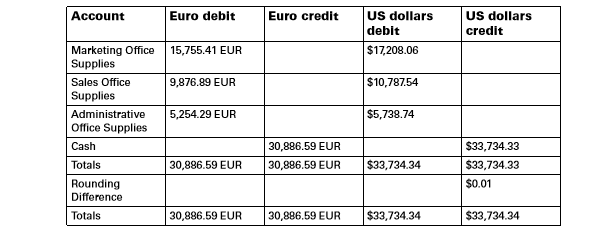
If you’re using Multicurrency Management, your system might calculate a rounding difference and post that amount to the Rounding Difference account if a transaction’s originating debits and credits balance, but the converted functional debits and credits don’t balance. The distribution for the rounding difference doesn’t show on the window, but does show in the posting journal.
Example
You use US dollars as your functional currency and you have a checkbook that uses Swiss francs. The exchange rate is 1.5 using the divide method, and you enter a transaction for CHF 1,500 that’s going to a Cash account ($1,000 US). The distributions are described in the following table:
| Distribution | Amount |
|---|---|
| Account #1 | 500 CHF ($333.33 US) |
| Account #2 | 500 CHF ($333.33 US) |
| Account #3 | 500 CHF ($333.33 US) |
The total amount distributed is $999.99 US, while the converted amount in the Cash account is $1,000.00 US, which leaves $0.01 US as a rounding difference.
You can record and post transactions related to checks, withdrawals, and other adjustments.
This information is divided into the following sections:
Use the Bank Transaction Entry window to enter checks, withdrawals, and increase or decrease adjustments.
Use withdrawal transactions to record cash withdrawals from a checkbook. For example, you can record an insurance payment that is automatically deducted from your checkbook on a monthly basis as a withdrawal transaction. Withdrawal transactions decrease the checkbook balance when you post.
For adjustments, use the Bank Transaction Entry window to record debit amounts— other than deposits—that increase the checkbook balance when they’re posted (increase adjustment transactions). Use decrease adjustment transactions to record amounts that decrease the checkbook balance when they’re posted, such as bank service charges. See Entering a miscellaneous bank adjustment transaction for information about entering an adjusting amount after reconciling.
If you’re using other modules such as Payables Management to track certain kinds of checks, you should enter those check transactions in those modules, not in Bank Reconciliation. Entering them in both places duplicates the credit from the Cash account and creates an extra check in Bank Reconciliation.
Use the following procedure only to enter transactions that haven’t originated in another module. These transactions update both the checkbook balance and the General Ledger Cash account when you post.
To transfer funds from one checkbook to another, use the Bank Transfer Entry window. See Chapter 7, “Receipts,” and Chapter 8, “Deposits,” for information about entering receipts and deposits.
To enter a check, withdrawal, or adjustment transaction:
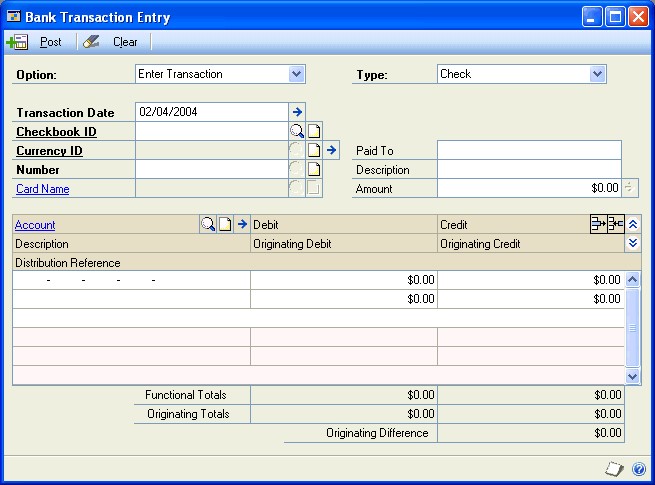
You can create individual checks to make a one-time payment when you don’t want to create a vendor record for the person or business you’re paying. Use the Miscellaneous Check window to print checks for one-time purchases that are not recorded as transactions anywhere else. You can print and post a check from this window, or you can post checks from this window without printing them.
To enter a miscellaneous check:
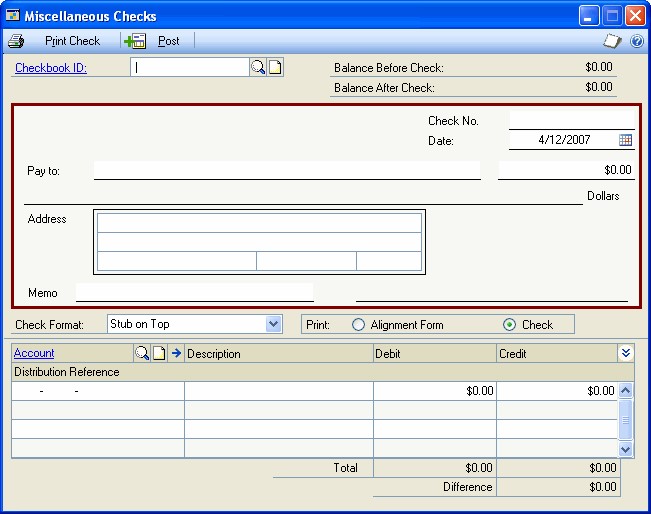
When you void a posted transaction entered in Bank Reconciliation, the amounts posted to accounts are reversed and the checkbook balance is updated by the voided transaction amount.
If you must void a transaction you entered in another module, you should use that module to void the transaction so you keep accurate accounting records throughout the system. When you void the transaction in the originating module, the checkbook is updated in Bank Reconciliation.
The following conditions must exist before you can void a transaction:
Use the Bank Transaction Entry window to void transactions that were entered and posted in Bank Reconciliation. If you entered and posted a transaction in another module, see that module’s documentation for information about how to void the transaction.
To void a bank transaction:
Receipts are any type of payment a business might receive. Once receipts are entered in Bank Reconciliation or posted in other modules, they are available for deposit. Use the deposit entry procedures to enter deposits for transactions with and without receipts. You also can clear receipts if you identify individual receipts that should be removed.
Receipt transactions appear in Bank Reconciliation once they’ve been posted in other modules. However, you might need to enter cash receipts that aren’t related to a specific customer. For example, your business might receive an annual utility rebate from your electrical service provider.
This information is divided into the following sections:
Use the Bank Transaction Entry window to enter funds received by your company from another party. Typically, receipts appear in Bank Reconciliation when cash receipt transactions are posted in other modules. However, you might need to enter transactions for miscellaneous amounts that weren’t entered in other modules, such as payments received from employees for employee stock purchases.
When you post a receipt, the Cash account in General Ledger is updated by the amount of the receipt, depending on your posting setup, but the checkbook balance isn’t updated. When you assign receipts to deposits using the Bank Deposit Entry window, the checkbook balance is updated by the receipt amounts when the deposit is posted.
To enter a miscellaneous receipt:
You can void receipts using the Bank Transaction Entry window. When you void a receipt in Bank Reconciliation, the amounts posted to accounts when the receipt was posted are reversed.
The following conditions must exist before you can void a receipt:
Once a receipt is voided, you can’t deposit it. If you’re using Multicurrency Management, your system uses the original exchange rate for the void receipt to ensure that the General Ledger amounts are the same as the original receipt.
Use the Bank Transaction Entry window to void a receipt in Bank Reconciliation. If you entered and posted a receipt in another module, see that module’s documentation for instructions about how to void the receipt.
To void a receipt:
Voiding a receipt reverses the General Ledger distributions for the receipt, including the Cash account distribution. If you’re keeping history, the voided receipt still appears on reports and in inquiry windows, so you can accurately track information about the voided receipt. For example, if you accidentally entered and posted the same receipt twice, you would void one of the receipt transactions to help ensure your data was correct. Remember to void the receipt in the module where it was originally entered.
Clearing a receipt using the Bank Deposit Entry window removes the receipt from the list of receipts available for deposit. The account distributions are not affected and the receipt information appears on the posting journal, and in the inquiry windows, so you can view what was cleared from the checkbook. For example, you might have posted a single deposit without receipts that covered the amounts for several receipts. Once you receive those receipts, you must clear them without posting another deposit.
If you’re using Multicurrency Management, you can enter receipts that use a different currency from the ones assigned to your checkbooks, based on the following rules:
When you create a deposit for receipts that use non-functional currencies, both the originating and checkbook amounts appear in the scrolling window of the Bank Deposit Entry window. You might have realized gains or losses associated with the converted amount. If the exchange rate changes between the date when the receipt is posted and the date when it’s deposited, the realized gains and losses appear after the receipt is marked for deposit.
The following terms explain how the amounts are displayed in the window:
All the marked receipts for a particular currency use the same exchange rate. You can change the exchange rate for a receipt by marking the receipt, then choosing the Currency ID expansion button.
The following examples show what happens with the receipt amounts for a checkbook using the functional currency, and for a checkbook using a nonfunctional currency.
Functional currency assigned to checkbook
The functional and checkbook currencies both are in US dollars. The following receipts are posted:
| Original receipt amount | Exchange rate (multiply rate) | Functional amount |
|---|---|---|
| €100.00 | 1.04045 | $104.05 |
| CA$100.00 | 1.3 | $130.00 |
| US$100.00 | (functional) | $100.00 |
The amounts displayed in the Bank Deposit Entry window before marking receipts are described in the following table:
| Originating amount | Checkbook amount | Realized gain/loss |
|---|---|---|
| €100.00 | $104.05 | $0.00 |
| CA$100.00 | $130.00 | $0.00 |
| US$100.00 | $100.00 | $0.00 |
When you mark receipts for deposit, your system searches for an exchange rate based on the deposit date and the currency ID, then calculates the checkbook and functional amounts based on the rate found. If the functional amount value changes based on the new calculation, you have realized gains or losses, as displayed in the following table:
| Originating amount | Exchange rate | Checkbook amount and functional amount | Realized gain/ loss |
|---|---|---|---|
| €100.00 | 1.150 | $115.00 | $10.95 |
| CA$100.00 | 1.25 | $125.00 | ($5.00) |
| US$100.00 | (functional) | $100.00 | $0.00 |
If you unmark a receipt, the checkbook amount reverts back to the amount before the receipt was marked, and the realized gains/losses become zero.
Alternate currency assigned to checkbook
The checkbook amount for each receipt shows the amount calculated using the deposit exchange rate, regardless of whether the receipts have been marked. For a receipt that originated in an alternate currency, any realized gains or losses appear after you mark the receipts.
The functional currency is US dollars and the checkbook currency is Canadian dollars. The following receipts are posted:
| Original receipt amount | Exchange Rate | Functional amount |
|---|---|---|
| $100.00 | --- | $100.00 |
| CA$140.00 | 0.65 | $91.00 |
The amounts displayed in the Bank Deposit Entry window before marking the receipt, assuming a deposit exchange rate of $0.80 US to one Canadian dollar, are described in the following table:
| Originating amount | GL functional amount | Checkbook amount | Realized gain/ loss |
|---|---|---|---|
| $100.00 | $100.00 | CA$125.00 | $0.00 |
| CA$140.00 | $112.00 | CA$140.00 | $0.00 |
The amounts displayed in the Bank Deposit Entry window after marking the receipt, assuming a deposit exchange rate of $0.80 US to one Canadian dollar, are described in the following table:
| Originating amount | GL functional amount | Checkbook amount | Realized gain/ loss |
|---|---|---|---|
| $100.00 | $100.00 | CA$125.00 | $0.00 |
| CA$140.00 | $112.00 | CA$140.00 | $21.00 |
Bank Reconciliation enables you to manage your deposits by entering deposits with receipts, without receipts, and to clear receipts. You also can void deposits.
This information is divided into the following sections:
You can enter the following deposit types in Bank Reconciliation:
Use the Bank Deposit Entry window to choose the receipts to deposit. All the selected checkbook’s receipts that are available for deposit appear in the window, including receipts entered in other modules. After you post a deposit with receipts transaction, the receipts aren’t available for future deposits.
The checkbook balance is updated by the deposit amount when you post. General Ledger isn’t updated, because the Cash account was updated when the receipts were posted in other modules or in the Bank Transaction Entry window. To enter a transaction to update General Ledger, you could enter an increase adjustment in the Bank Transaction Entry window.
Negative receipts might appear as selections in the scrolling window if you have a sales deposit that has been removed from an order or back order in Sales Order Processing; a cash refund for a merchandise return in Sales Order Processing or Receivables Management; or if the receipt for the original transaction already has been deposited.
If you’re doing business in Australia or New Zealand and you’re required to include bank and branch information on the Bank Deposit Worksheet, or if you want to change the bank or branch name for each receipt, you can enter the information in the Bank Deposit Entry window and use Report Writer to modify the report. See the Report Writer documentation for more information.
To enter a deposit with receipts:
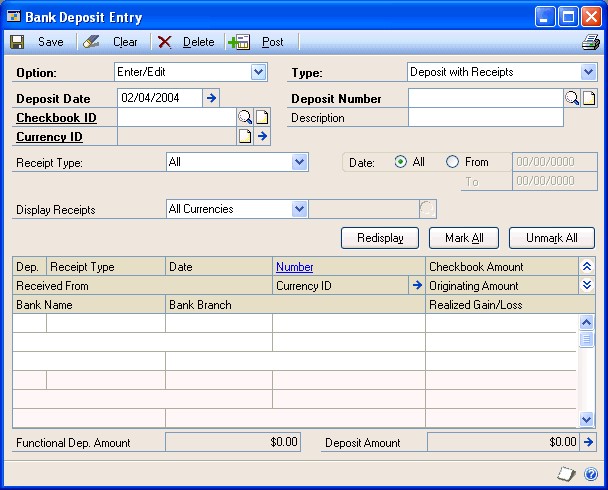
The Deposit Totals window displays the number of checks, credit cards, and cash receipts you marked for deposit, and the total monetary amounts for each type. You can enter separate totals for coin and currency.
Example 1
You entered a cash receipt total of $117.65. The amount of $117.00 appears in the Currency Total Amounts field and $0.65 appears in the Coin Total Amounts field, as shown in the following table:
| Item | Number | Total amounts |
|---|---|---|
| Checks | 4 | $28,000.00 |
| Credit Cards | 1 | $52.00 |
| Currency | 1 | $117.00 |
| Coin | $0.65 | |
| Total | 6 | $28,169.65 |
If Multicurrency Management is registered, you can browse through this information for each currency.
Example 2
You entered a cash receipt total of $117.65. The actual coin amount is $16.65, and the total for the paper money is $101.00. If you enter $101.00 in the Currency Total Amounts field, the coin amount is adjusted to display $16.65, as shown in the following table.
| Item | Number | Total amounts |
|---|---|---|
| Checks | 4 | $28,000.00 |
| Credit Cards | 1 | $52.00 |
| Currency | 1 | $101.00 |
| Coin | $16.65 | |
| Total | 6 | $28,169.65 |
If Multicurrency Management is registered, you can browse through this information for each currency.
Use the Bank Deposit Entry window to enter deposits without receipts to record a lump-sum deposit without assigning receipts.
For example, suppose you entered a deposit to clear receipts because you didn’t want to assign individual receipts to a deposit. You can then enter a deposit without receipts transaction for the total amount of the receipts you just cleared. Unlike deposits with receipts and deposits to clear receipts, you can enter and save an unlimited number of deposit without receipts transactions for each checkbook.
When you enter a deposit without receipts transaction, the total amount of the deposit appears in the Checks Total Amounts field in the Deposit Totals window. To enter individual totals for check, credit card, currency, and coin amounts, choose the Deposit Amount expansion button in the Bank Deposit Entry window to open the Deposit Totals window.
When you post a deposit without receipts transaction, the checkbook balance is updated by the deposit amount. If you need to enter a transaction to update General Ledger, enter an adjustment, instead of a deposit without receipts, in the Bank Transaction Entry window to ensure that the checkbook balance isn’t updated twice. See Entering a check, withdrawal, or adjustment transaction for more information.
To enter a deposit without receipts:
Use the Bank Deposit Entry window to remove receipts you don’t want to assign individually to a deposit. For example, if you entered a deposit without receipts transaction because you don’t want to assign individual receipts to a deposit, you can remove the receipts by entering a deposit to clear receipts transaction. You can save only one deposit to clear receipts or deposit with receipts transaction at a time for each checkbook.
Use a deposit to clear receipts transaction to remove the receipts from the system, if you have existing receipts that won’t be assigned to a specific deposit because the amount has already been deposited. When you enter a deposit to clear receipts transaction, the deposit amount is zero, and the checkbook balance and General Ledger Cash account aren’t updated when you post. The Cash account was updated when the receipts were posted in subsidiary modules or in the Bank Transaction Entry window.
To clear a receipt from a deposit:
Use the Bank Deposit Entry window to void a deposit. Unlike deleted deposits, voided deposits are kept in history, if you’re keeping bank transaction history. The following table explains what happens when you void the different deposit types:
| Voided transaction | What happens |
|---|---|
| Deposit with receipt | Any receipts assigned to the deposit are unmarked and you can reassign them to another deposit. The checkbook balance is updated by the voided deposit amount. |
| Deposit without receipt | The checkbook balance is updated by the voided deposit amount. |
| Deposit to clear receipts | Any receipts assigned to the deposit are unmarked and you can reassign them to another deposit. The checkbook balance is not changed because the balance wasn’t updated when the actual deposit was posted. |
If Multicurrency Management is registered and the receipts on the original deposit had a realized gain or loss, the amount of the gain or loss is reversed. Your system uses the exchange rate from the original deposit to ensure that the amounts are updated correctly. If you’re not keeping history, the deposit information is deleted.
The following conditions must exist before a you can void a deposit:
To void a deposit:
Use the Bank Deposit Entry window to delete deposits. You can delete a deposit that has been saved, but not posted. All receipts assigned to the deposit are unmarked and become available for deposit. When you delete a deposit, historical records are not updated.
To delete a deposit:
Transferring funds from one checkbook to another ensures that your accounts contain the correct amounts for your accounting activities. For example, you might want to transfer funds from your general checkbook account to your payroll checkbook account before each payday.
This information is divided into the following sections:
Use the Bank Transfer Entry window to transfer funds from one checkbook to another. The default transfer number for each transaction increments from the previous number, and the three-letter code is based on your selections in the Bank Reconciliation Setup window. You can use duplicate transfer numbers.
To transfer funds, both checkbooks must be assigned the same currency, or one checkbook must be assigned to the functional currency. The multicurrency transfer date and currency ID determine the exchange rate for transfers.
To transfer funds between checkbooks:
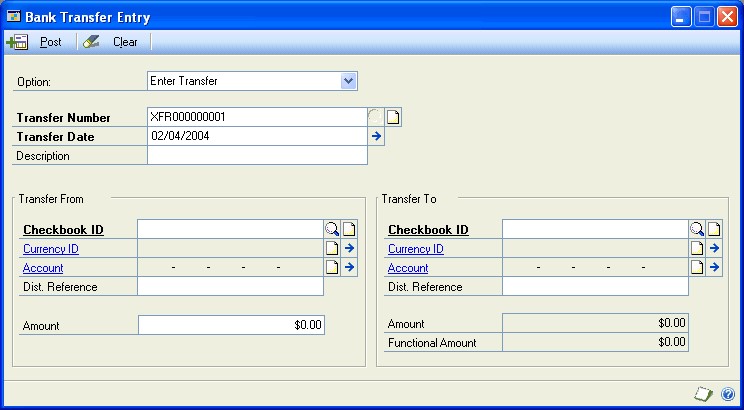
When you void transfers, the original transfer date appears. The transfer transaction must meet the following conditions before it you can void it:
If you use duplicate transfer numbers, be sure to select the correct transaction from the list in the lookup window.
To void a bank account transfer:
Reconciling is the process that identifies discrepancies that might exist between a checkbook’s register and the bank statement for that checkbook. Once you review your bank statement and enter adjusting amounts, you can reconcile to ensure that the balance in your checkbook matches the balance reported on your bank statement. If you’re keeping history, transactions become historical records once they’ve been reconciled.
This information is divided into the following sections:
To reconcile your checkbook with your bank statement, mark the transactions that have cleared the bank and check the amounts against those that appear on the statement. If a transaction cleared the bank for a different amount than was entered, you can enter the difference and distribute the amount to the posting account of your choice. You also can enter adjusting entries to track interest income, other expenses or income, and service charges, so that you can reconcile the checkbook properly. If you’re not keeping history, the transaction information is deleted after reconciling.
The checks you mark as cleared are reclassified as historical records (if you’re keeping history), and appear on historical transaction reports after you reconcile.
Use the Reconcile Bank Statements window to reconcile the cash-related transaction information you entered with the transaction information recorded by the banking institution.
Before reconciling, back up all your company’s accounting data. See the System Administrator’s Guide (Help >> Contents >> select System Administration) for more information about making backups.
To reconcile a bank statement with a checkbook:
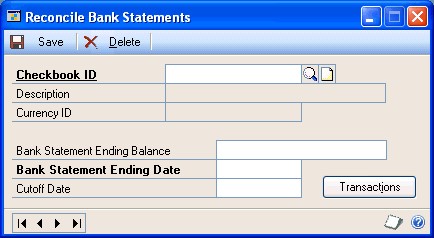
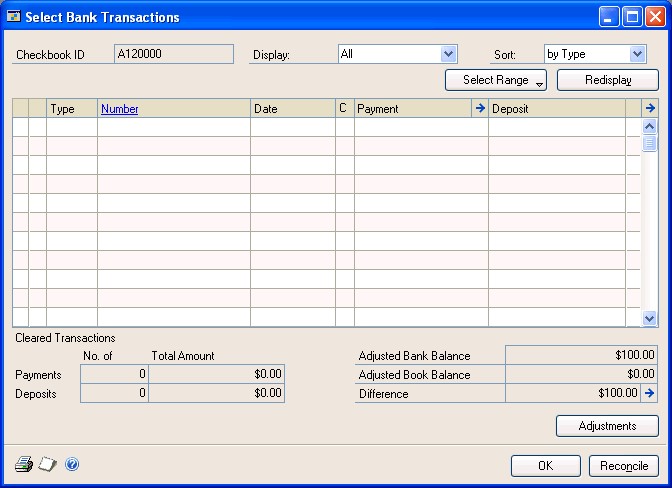 If you’re editing saved reconciliation information, the transactions you marked previously remain marked. The totals for the payments and deposits in the cleared transaction section of the Select Bank Transactions window include only payments and deposits. The totals do not include adjustment transactions.
If you’re editing saved reconciliation information, the transactions you marked previously remain marked. The totals for the payments and deposits in the cleared transaction section of the Select Bank Transactions window include only payments and deposits. The totals do not include adjustment transactions.Tip Use the spacebar to mark the check box. The arrows on the sides of the scrolling window are visual indicators that show which line you’re currently focused on.
The number of cleared transactions and the total amount are updated as you mark each transaction. You can view the original entries by selecting a transaction and choosing the Number link. To mark or unmark a range of documents, select the first transaction to include and choose Range >> Begin Range. A left arrow symbol (<) appears next to the transaction in the Type column, identifying the beginning of the range. Select the last transaction to include in the range and choose Range >> End Range. A right arrow symbol (>) appears next to the transaction in the Type column, indicating the end of the range. An asterisk appears next to each transaction included in the range. Choose Range >> Mark to mark those transactions as cleared. Choose Range >> Unmark to unmark a range of transactions.
Note The Cleared Transactions section of this window includes only payments and deposits. Adjustments are not included in the totals.
| Report | Displays |
|---|---|
| Reconciliation Edit List | Checkbook and bank statement balance information |
| Bank Adjustments Edit List | Adjustment transactions entered using the Reconcile Bank Adjustments window |
| Marked Transactions Report | Transactions that have been marked as cleared |
| Outstanding Transactions Report | Transactions that haven’t cleared the bank, and that fall between the bank statement ending date and the cutoff date entered in the Reconcile Bank Statements window |
When the process is complete, the Reconciliation Posting Journal, Bank Adjustments Posting Journal, and Cleared Transactions Journal are printed. The Last Reconciled Balance and Last Reconciled Date fields for this checkbook in the Checkbook Maintenance window are updated with the bank statement ending balance and the bank statement ending date.
Use the Reconcile Bank Adjustments window to enter adjustment transactions—such as service charges, interest income received, and other income or expenses—to adjust the checkbook balances. These adjustments must be entered in the same currency as the checkbook.
To enter a miscellaneous bank adjustment transaction:
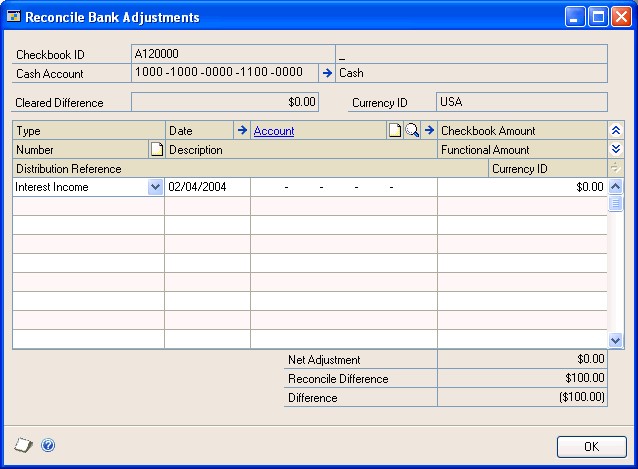
Sometimes a check might clear the bank for an amount that’s different than the amount you recorded. When transactions clear the bank for a different amount than what was posted, and a different cleared amount is entered in the Cleared Amount Entry window, an information icon appears for those transaction amounts in the Select Bank Transactions window. This indicates that the cleared amount for the transaction is different from the amount entered in the checkbook. The posted amount appears in the Select Bank Transactions window, and the cleared amount appears as the total amount for cleared transactions.
To enter cleared differences:
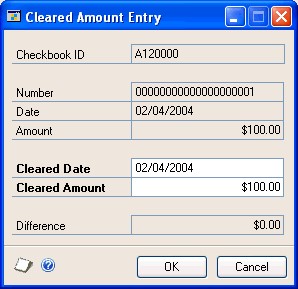
When you finish, the difference should be zero. If the difference isn’t zero, you should complete the following tasks:
You can print preview reports before reconciling to verify the transactions you marked as cleared, or the adjustments you entered. Use the Select Bank Transactions window to print preview reports:
Choose File >> Print in the Select Bank Transactions window to print any or all the reports. The Print Reconciliation Reports window opens, where you can mark the reports to be printed.
Your system stores a vast amount of detailed information about your cash-related transactions. You can use inquiries and reports to view and analyze information about a specific transaction, or to obtain general information about a group of transactions.
This part of the documentation contains procedures for removing history from Bank Reconciliation, and explains the routine checklists.
The following topics are discussed:
Use inquiries to view checkbook register information. Because the inquiry windows provide efficient access to information, you always can view your current checkbook activity.
This information is divided into the following sections:
You can view multicurrency amounts in the originating, functional, or reporting currency. Choose View >> Currency >> Functional, Originating, or Reporting while viewing an inquiry window. The option is saved on a per user, per window basis.
You also can use the Currency list button in windows that support changing the currency view. The View menu and currency list button are available in the Checkbook Register Inquiry and Bank Transaction Entry Zoom windows.
The first time you open these windows after registering Multicurrency Management, all the transactions are displayed in the originating currency. If you change the currency view, the option you used last is the default view the next time you open that window.
A reporting currency converts functional currency amounts to another currency on inquiries and reports. For example, suppose the U.S. dollar is the functional currency for your company. You can set up the euro as your reporting currency to view an inquiry window with currency amounts displayed in the euro currency.
During the reporting currency setup process in Multicurrency Management, you’ll set up a reporting currency and enter a default exchange rate and rate calculation method. Depending on how your system is set up, you might be able to override the default reporting currency exchange rate or rate calculation method on inquiries and reports. To change the default reporting currency exchange rate, choose View >> Currency >> Modify Reporting Rate to open the Modify Reporting Rate window.
See the Multicurrency Management documentation for more information about the reporting currency.
You can use the Checkbook Register Inquiry window to view reconciled and unreconciled transactions that have been posted for a checkbook. You also can sort transactions by number or by date, and further limit the transactions that appear by selecting a range of document numbers or document dates.
You also can view transactions as they were originally entered, using the different links in the Checkbook Register Inquiry window. You can view more detailed information about the transactions displayed in the scrolling window by selecting a transaction and choosing the Number link. You can’t view the original transaction entry window if you’re not keeping history for that module, or if history has been removed.
Use the Checkbook Register Inquiry window to find out more information about transactions posted to your checkbooks.
To view checkbook information:
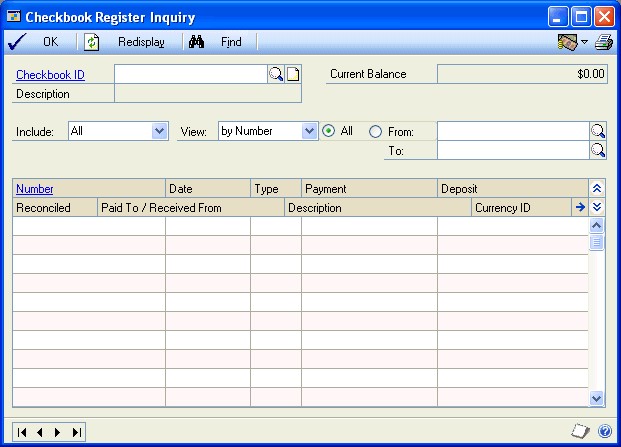
| Transaction type | Window |
|---|---|
| Deposit | Bank Deposit Entry Zoom |
| Bank Transaction | Bank Transaction Entry Zoom |
| Transfer | Bank Transfer Entry Zoom |
| Payables payments | Payables Payments Zoom |
| Receivables return with check amount | Receivables Transaction Inquiry Zoom |
| NSF checks received | Cash Receipts Inquiry Zoom |
| Check payment on return in Invoicing | Invoice Inquiry |
| Check payment on return in Sales Order Processing | Sales Transaction Inquiry |
| Check payment in Payroll | Payroll Check Inquiry |
Use the Checkbook Balance Inquiry window to view a checkbook balance for a specific date.
If you are using reporting ledgers, the amount shown in the Current Cash Account Balance field is based on the ledgers selected in the General Ledger Setup window in the Account Balance for Subsidiary Windows list. For more information on using reporting ledgers, see the General Ledger documentation.
To view historical checkbook balances:
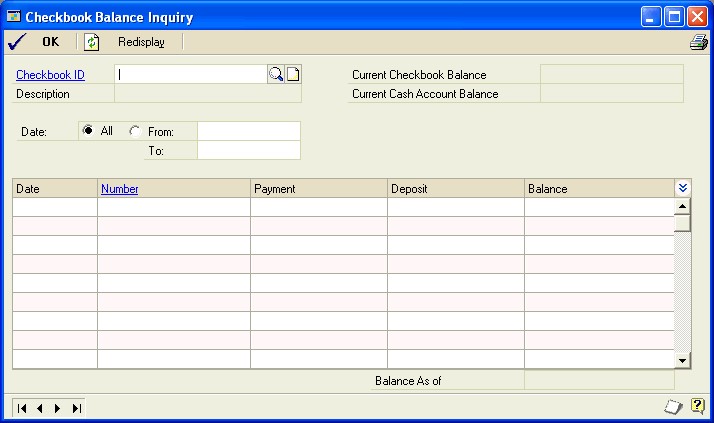
| Transaction type | Window |
|---|---|
| Deposit | Bank Deposit Entry Zoom |
| Bank Transaction | Bank Transaction Entry Zoom |
| Transfer | Bank Transfer Entry Zoom |
| Payables payments | Payables Payments Zoom |
| Receivables return with check amount | Receivables Transaction Inquiry Zoom |
| NSF checks received | Cash Receipts Inquiry Zoom |
| Check payment on return in Invoicing | Invoice Inquiry |
| Check payment on return in Sales Order Processing | Sales Transaction Inquiry |
| Check payment in Payroll | Payroll Check Inquiry |
You can use Bank Reconciliation reports to analyze checkbook activity and identify errors in transaction entry. Use this information to guide you through printing reports and working with report options. For more information about creating and printing reports, and the various reporting tools that you can use with Microsoft Dynamics GP, refer to your System User's Guide (Help >> Contents >> select Using The System).
Reports information is divided into the following sections:
You can print several types of reports using Bank Reconciliation. Some reports automatically are printed when you complete certain procedures; for example, posting journals can automatically be printed when you post transactions, depending on how your posting options are set up. You can choose to print some reports during procedures; for example, you can print an edit list when entering transactions by choosing the Print button in the batch entry window. In order to print some reports, such as analysis or history reports, you must set up report options to specify sorting options and ranges of information to include on the report. For more information, refer to Specifying a Bank Reconciliation report option.
The following table lists the report types available in Bank Reconciliation and the reports that fall into those categories. Reports printed using General Ledger are printed using many of the same windows. See the General Ledger documentation for information about reports printed in that module.
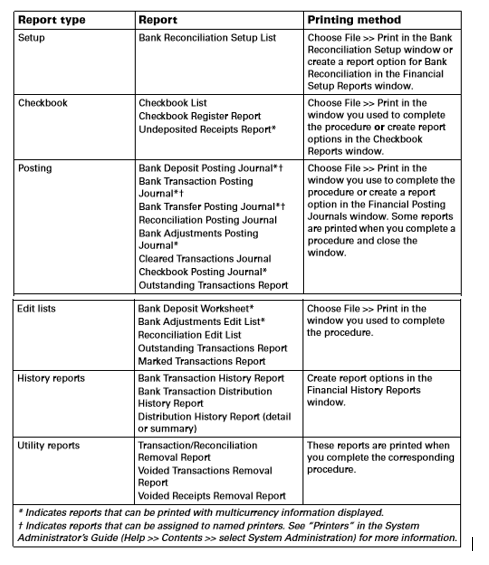
Report options include specifications for sorting options and range restrictions for a particular report. In order to print Bank Reconciliation reports, you must first create a report option. Each report can have several different options so you can easily print the information you need. For example, you can create report options for the Checkbook Register to include any combination of reconciled, unreconciled, and voided transactions.
A single report option can’t be included in multiple reports. If you want identical options for several reports, you must create them separately.
Use the Financial report options windows to create sorting, restriction, and printing options for the reports that are included in Bank Reconciliation.
To specify a Bank Reconciliation report option:
Note You can enter only one restriction for each restriction type. For instance, you can insert one Checkbook ID restriction (CASH to PAYROLL) and one Description restriction (Z-AUSTRALIA to Z-CANADA).
Historical records provide useful information for auditing. You can keep records of transaction and reconciliation history for an unlimited number of years. Once you decide how much historical information is necessary, you can remove information when it’s no longer useful, or when you need to make hard disk space available.
This information is divided into the following sections:
When you’re using Bank Reconciliation, you can store transaction and reconciliation history, which contains records of transactions that have been entered, posted, and reconciled. If you keep Transaction/Reconciliation history, account distribution information is saved and reprint posting journals are available, as long as you chose to reprint the posting journals in the Audit Trail Codes Setup window.
If you didn’t choose to keep history in the Bank Reconciliation Setup window, documents are removed after they’ve been reconciled or voided, and reprint posting journals are not available.
Before removing history, back up your company’s accounting data. Removing history permanently deletes the historical information from your company data. See the System Administrator’s Guide (Help >> Contents >> select System Administration) for more information about making backups.
Because historical records increase the amount of hard disk space needed to run your system, you should remove history periodically. You can remove the following types of Bank Reconciliation history:
Use the Remove Bank History window to remove history, and increase the amount of available space on your hard disk. After you remove history, you won’t be able to print reports that list the information that was removed, nor view the information in inquiry windows.
To remove bank history:
Note Once you remove history for a range of transactions, you can’t reprint the Remove History Report for the selected range.
| History removed | Report printed |
|---|---|
| Transaction/Reconciliation | Transaction/Reconciliation Removal Report |
| Voided transactions | Voided Transactions Removal Report |
| Voided receipts | Voided Receipts Removal Report |
To review detailed information about each feature, click the relevant link below.
Automatically Deposit Cash Receipts
Previously in Dynamics GP, to use the Auto Deposit functionality, the user was required to have Analytical Accounting installed. In Dynamics GP 2015 R2 and later versions, the Auto Deposit functionality can be used with or without Analytical Accounting installed. This company setup option allows for cash receipts entered in Receivables Management to directly update the checkbook balance when posted. You will not be required to post the cash receipt again from the Bank Deposit Entry window (Transactions >>Financial >> Bank Deposits) in Bank Reconciliation if you mark this option.
Bank Reconciliation history tracking and transaction remove capability which = better performance
With the release of Dynamics GP 2016 R2 came a great new feature that will help the customers that use Bank Reconciliation heavily, or have been using Dynamics GP with Bank Reconciliation for a long time. The new feature is the addition of the Reconciled Transaction Maintenance process! The goal for this additional routine for Bank Reconciliation will be increased performance for various Bank Reconciliation processes after moving the bulk of Reconciled Transactions to History.
Don't display inactive checkbooks in Lookups
With the release of Dynamics GP 2018 R2, users can choose to exclude 'Inactive Checkbooks' in the Checkbooks Lookup window. In earlier versions of Dynamics GP, all Checkbook IDs are displayed in the Checkbooks Lookup window. The 'Exclude Inactive Checkbooks' option has been added to the Checkbooks Lookup window to accommodate this new functionality.
Prevent duplicate check numbers
With the release of Dynamics GP 2018 R2, it is possible to prevent using a duplicate check number in the Bank Transaction Entry, Miscellaneous Checks, and the Payroll Manual Check-Adjustment Entry windows.
In earlier versions of Dynamics GP, it was not possible to prevent users from using duplicate check numbers in the Bank Transaction Entry, Miscellaneous Checks, and the Payroll Manual Check-Adjustment Entry windows.
When the 'Duplicate Check Numbers' option is unmarked: Dynamics GP will prevent users from using a duplicate check number in the Bank Transaction Entry, Miscellaneous Checks, and the Payroll Manual Check-Adjustment Entry windows.